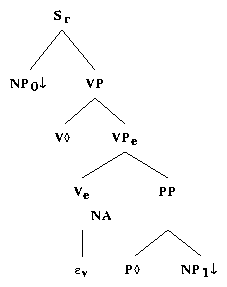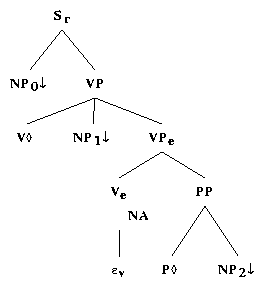

We will call verbs such as venture transitive PP complement verbs. There are also ditransitive PP complement verbs, such as put.
Since the PP in examples like ((141)) and ((143)) is an argument of the verb, PP complement verbs such as venture and put must provide a substitution site for the PP. There are two possible structures for allowing this in the grammar: the PP substitution node structure (shown in Figure 11.1a) and the expanded PP structure (shown in Figure 11.1b).
 |
 |
|
| (a) PP substitition | (b) Expanded PP |
The structure chosen is that of the expanded PP in Figure 11.1b. The choice was motivated by two reasons. The first is that it is possible to extract the NP object of the P, as shown in ((145)), and expanding the PP allows the NP node to be available to metarules which create the trees for extraction.
The second reason has to do with the inherent semantics of the elementary trees of such verbs. Currently, we treat the verb as taking the NP, the object of the preposition, as its argument rather than the whole PP. In order to have access to this NP for the semantic representation, it must be explicitly represented in the elementary tree. However, the current XTAG grammar does not parse sentences like ((146)) in which the verb takes exhaustive PP's like there (and also somewhere, where etc.) as its argument.
Since the existing analysis does not allow an exhaustive PP substitution, these cases are currently a problem. There is another class of PP complement verbs which make it necessary to expand the PP structure. These are the verbs which require a particular preposition to head their PP complement, as illustrated in the following examples:
For such verbs, the preposition is intrinsic to the construction. Note that sentence ((149)) is ambiguous between two interpretations, one in which the PP is an adjunct and the other in which it is a complement. The adjunct interpretation of this sentence is something like ``Calvin was thinking and the topic of this thought was the transmogrifier'' while the complement interpretation is ``Calvin created the idea for the transmogrifier''. The preposition correlated with the verb thus conveys a noncompositional meaning, which motivates us to analyze these constructions as being multiply-anchored by a verb and a corresponding preposition. Having the P as one of the anchors necessitates the expansion of the PP complement for these constructions. We have thus determined one important motivation for the suggested basic structure of PP complement verbs. Another important aspect of these verbs is that, contrary to cases where verbs take an NP complement, certain adjuncts are found to occur relatively freely between the verb and the PP complement. NP complements cannot be separated from the verb by modifiers unless they are heavy, as shown in examples ((154)-(157)).
PP complements, however, allow several types of adjuncts in this position. For example, adverbs ((158)-(160)), certain prepositional phrases ((161)-(163)), and nominal adjuncts ((164)-(166)) are able to intercede the verb and the preposition:
Some restrictions, however, do occur. The locative PP's in (167)-(169) and the adjunct clauses in (170)-(172) cannot intervene between the verb and its PP complement.
There are several ways in which we could handle these adjuncts. One of these is to allow only certain adjuncts to adjoin to V. However, this is unappealing because it would cause right-edge ambiguities (V vs. VP adjunction), and also because it cannot handle examples like ((160)), ((163)), ((166)), and ((169)) where there is an NP between the verb and the preposition. Another option is to make the claim that the adjuncts get into the intervening position because of heavy-shift. With such an analysis, the structures of the trees for prepositional complements would not provide a site for adjunction between the verb and the preposition. However, there is no sense of heaviness in the examples ((158)-(169)), and we would expect ((170)),((171)), and ((172)) to be fine since the PP's are quite heavy here. The analysis we provide is structural, and is given in Figure 11.2 for the multi-anchor PP complement verbs. The analysis suggests short verb movement, and is reminiscent of Larsonian shells. However, the most important aspect of these trees for the purposes of the English XTAG grammar is that it provides a site for left adjunction to VP that intervenes between the verb and the preposition. This immediately rules out the adjunct clauses as desired, since such clauses only right adjoin to VP in the grammar. Most prepositional phrases are not good in the intervening position either, and this fits in nicely with the fact that the grammar does not have left VP adjoining prepositional phrases. For the restricted class of prepositions which are permitted in the intervening position, the grammar currently does not parse them, but entries which allow such left adjuction can be easily added later. Adverbs, however, already left-adjoin to VP's in the current grammar, so the structure accomodates this without need of any further modification. The comparatives also provide motivation for the structure that we have adopted. Comparative adverb phrases such as more heavily may either left- or right-adjoin, and can thus adjoin in the intervening position. However, the than-clause portion of a comparative can only right adjoin. Together, these two adjoining behaviors work with our PP complement analysis to correctly capture the distinctions seen in the following examples:
In ((173)), the comparative adverb phrase has left-adjoined to the lower VP and the than-clause has right adjoined to it. In ((174)), both are right adjoined. The ungrammaticality of ((175)) is captured by the fact that the than-clause can only right-adjoin, and there is no right-adjoinable VP node available between the verb and the preposition.
 |
 |
|
| (a) nx0VPnx1 | (b) nx0Vnx1Pnx2 |
This basic schema of short verb movement for PP complement families captures the adjunction possibilities directly and appears to partition the different types of adjoining elements in the appropriate way, with very little modification to the grammar. The analysis is operative in the families Tnx0Vpnx1, Tnx0Vnx1pnx2, Tnx0VPnx1, and Tnx0Vnx1Pnx2. Notice that having two VP nodes along the right spine of the trees will engender right edge ambiguities. In other structures where this ambiguity arises (for example, sentences with auxiliaries), VP right-adjoining modifiers are restricted by the feature mainv = + on their footnodes to avoid right-edge ambiguities. This restriction is extended to the present case where right VP adjunction is allowed to occur only on the higher VP by giving the lower VP the feature mainv = -.